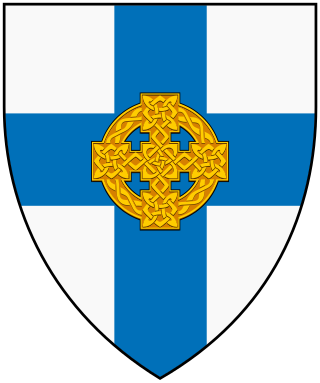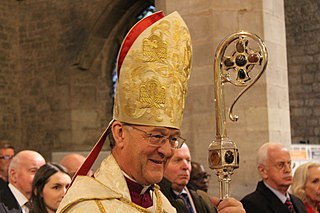The Bishop of Swansea was an episcopal title used by a suffragan bishop of the Diocese of St David's, [1] in the Church of England Province of Canterbury until 1920 and then in the Church in Wales.It took its name after the town of Swansea, then in Glamorganshire; since the erection of the Diocese of Swansea and Brecon in 1923, the title has been united to the diocesan Bishop of Swansea and Brecon. [2]
| Bishops of Swansea | |||
|---|---|---|---|
| From | Until | Incumbent | Notes |
| 1890 | 1915 | John Lloyd | Died in office. [3] |
| 1915 | 1923 | Edward Bevan | Church in Wales from 1920; elected first diocesan Bishop of Swansea and Brecon at that diocese's erection. [4] |

The Church in Wales is an Anglican church in Wales, composed of six dioceses.
A suffragan bishop is a type of bishop in some Christian denominations.
The post of Archbishop of Wales was created in 1920 when the Church in Wales was separated from the Church of England and disestablished. The four historic Welsh dioceses had previously formed part of the Province of Canterbury, and so came under its Archbishop. The new Church became the Welsh province of the Anglican Communion.
The Bishop of Ripon is an episcopal title which takes its name after the city of Ripon in North Yorkshire, England. The bishop is one of the area bishops of the Diocese of Leeds in the Province of York. The area bishop of Ripon has oversight of the archdeaconry of Richmond and Craven, which consists of the deaneries of Bowland, Ewecross, Harrogate, Richmond, Ripon, Skipton, and Wensley.
The Bishop of Wakefield is an episcopal title which takes its name after the city of Wakefield in West Yorkshire, England. The title was first created for a diocesan bishop in 1888, but it was dissolved in 2014. The Bishop of Wakefield is now an area bishop who has oversight of an episcopal area in the Diocese of Leeds.

The Bishop of Swansea and Brecon is the Ordinary of the Church in Wales Diocese of Swansea and Brecon.

The Diocese of Menevia is a Latin Church diocese of the Catholic Church in Wales. It is one of two suffragan dioceses in the ecclesiastical province of Cardiff and is subject to the Archdiocese of Cardiff.

The Suffragan Bishops Act 1534 is an Act of the Parliament of England that authorised the appointment of suffragan bishops in England and Wales. The tradition of appointing suffragans named after a town in the diocese other than the town the diocesan bishop is named after can be dated from this act.
The Bishop of Maidstone is an episcopal title used by a suffragan bishop of the Church of England Diocese of Canterbury, in the Province of Canterbury, England. The title takes its name after the county town of Maidstone in Kent.
The Bishop of Berwick is an episcopal title used by the suffragan bishop of the Church of England Diocese of Newcastle in the Province of York, England.
Alan Wyndham Morgan, was the Bishop of Sherwood, a suffragan bishop in the Church of England Diocese of Southwell, from 1989 until 2004.
Edward Latham Bevan was a Welsh churchman, the inaugural Bishop of Swansea and Brecon from 1923 until his death, having previously been the final suffragan Bishop of Swansea.

John David Edward Davies KStJ is a retired Welsh Anglican bishop and former solicitor. From 2008 he was the Bishop of Swansea and Brecon in the Church in Wales. On 6 September 2017, he was also elected Archbishop of Wales; he continued in his role as diocesan bishop. He retired from both offices with effect from 2 May 2021.
The Bishop of Loughborough is an episcopal title used by the sole suffragan bishop of the Church of England Diocese of Leicester in the Province of Canterbury, England.

The Anglican Diocese of Leeds is a diocese of the Church of England, in the Province of York. It is the largest diocese in England by area, comprising much of western Yorkshire: almost the whole of West Yorkshire, the western part of North Yorkshire, the town of Barnsley in South Yorkshire, and most of the parts of County Durham, Cumbria and Lancashire which lie within the historic boundaries of Yorkshire. It includes the cities of Leeds, Bradford, Wakefield and Ripon. It was created on 20 April 2014 following a review of the dioceses in Yorkshire and the dissolution of the dioceses of Bradford, Ripon and Leeds, and Wakefield.
The Archdeacon of Brecon is a senior ecclesiastical officer in the Church in Wales Diocese of Swansea and Brecon. The archdeacon is the senior priest with responsibility over the area of the archdeaconry of Brecon, which comprises the five rural deaneries of Brecon, Builth, Crickhowell, Hay and Maelienydd.
The Bishop of Leicester was a suffragan bishop of the Church of England Diocese of Peterborough in the Province of Canterbury.
John Lloyd was a British Anglican bishop. He served as the Bishop of Swansea from 1890 until his death in office.
The Anglican dioceses of Mombasa are the Anglican presence in and around Mombasa and south-east Kenya; they are part of the Anglican Church of Kenya. The remaining dioceses of the Church are in the areas of Maseno, of Mount Kenya, and of Nakuru.